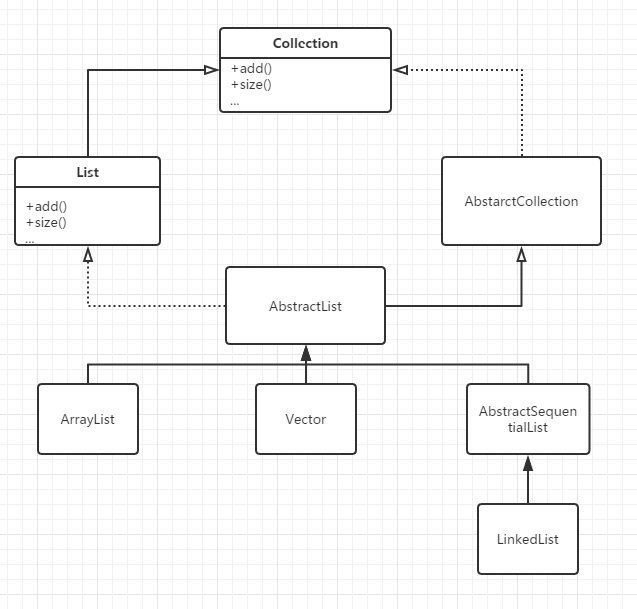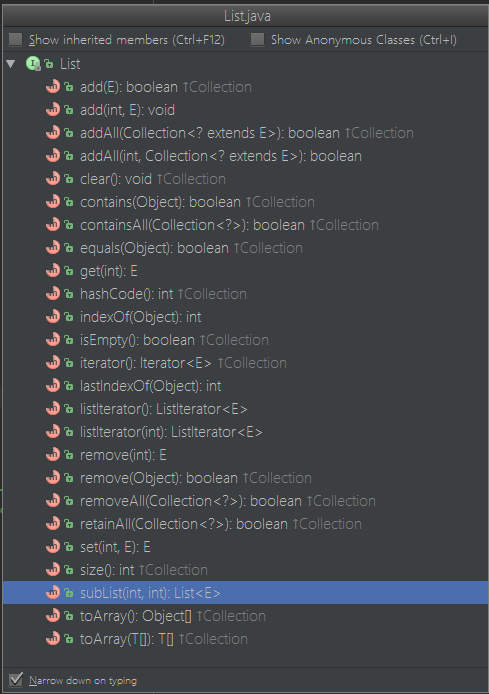Java集合详解 |
您所在的位置:网站首页 › java有哪几种集合 › Java集合详解 |
Java集合详解
|
简述
上章简单介绍了什么是集合,集合有哪几种种类。 在这章中我们主要介绍Collection的其中一种实现方式,List。 什么是List 在上一章,我们已经了解了List主要分为3类,ArrayList, LinkedList和Vector。 为了进一步清晰List的结构,我在这手工画了一张图,用于回顾下 AbstarctCollection在上一张Java集合详解–什么是集合已经有简单的介绍,它是Collection接口的部分实现 1.List接口 首先看下List的官方定义 这段描述解决了许多公司经常问的两个问题List有什么特点和Set有什么区别。 上面清楚的说明了List是一个有序的集合,和set不同的是,List允许存储项的值为空,也允许存储相等值的存储项,还举了e1.equal(e2)的例子。 List是继承于Collection接口,除了Collection通用的方法以外,扩展了部分只属于List的方法。 从上图可以发现,List比Collection主要多了几个add(…)方法和remove(…)方法的重载,还有几个index(…), get(…)方法。 而AbstractList也只是实现了List接口部分的方法,和AbstractCollection是一个思路,这里就不具体介绍了,有兴趣的同学可以自行研究下。 2.ArraryList ArrayList是一个数组实现的列表,由于数据是存入数组中的,所以它的特点也和数组一样,查询很快,但是中间部分的插入和删除很慢。我们来看几段关键的代码。 首先是ArrayList的类关系和成员变量 //ArrayList继承了Serializable并且申明了serialVersionUID,表示ArrayList是一个可序列化的对象,可以用Bundle传递 public class ArrayList extends AbstractList implements List, RandomAccess, Cloneable, java.io.Serializable { private static final long serialVersionUID = 8683452581122892189L; /** * Default initial capacity. */ private static final int DEFAULT_CAPACITY = 10; /** * Shared empty array instance used for empty instances. */ private static final Object[] EMPTY_ELEMENTDATA = {}; /** * The array buffer into which the elements of the ArrayList are stored. * The capacity of the ArrayList is the length of this array buffer. Any * empty ArrayList with elementData == EMPTY_ELEMENTDATA will be expanded to * DEFAULT_CAPACITY when the first element is added. */ //从这里可以看到,ArrayList的底层是由数组实现的,并且默认数组的默认大小是10 private transient Object[] elementData; /** * The size of the ArrayList (the number of elements it contains). * * @serial */ private int size;然后是构造函数 //ArrayList有2个构造函数,一个是默认无参的,一个是传入数组大小的 //在JavaEffect书中明确提到,如果预先能知道或者估计所需数据项个数的,需要传入initialCapacity //因为如果使用无参的构造函数,会首先把EMPTY_ELEMENTDATA赋值给elementData //然后根据插入个数于当前数组size比较,不停调用Arrays.copyOf()方法,扩展数组大小 //造成性能浪费 /** * Constructs an empty list with the specified initial capacity. * * @param initialCapacity the initial capacity of the list * @throws IllegalArgumentException if the specified initial capacity * is negative */ public ArrayList(int initialCapacity) { super(); if (initialCapacity < 0) throw new IllegalArgumentException("Illegal Capacity: "+ initialCapacity); this.elementData = new Object[initialCapacity]; } /** * Constructs an empty list with an initial capacity of ten. */ public ArrayList() { super(); this.elementData = EMPTY_ELEMENTDATA; }然后是add()操作 //首先看到,不过是指定index执行add操作,还是在尾部执行add操作,都会先确认当前的数组空间是否够插入数据 //并且从 //int oldCapacity = elementData.length; //int newCapacity = oldCapacity + (oldCapacity >> 1); //if (newCapacity - minCapacity < 0) // newCapacity = minCapacity; //看出,ArrayList默认每次都是自增50%的大小再和minCapacity比较,如果还是不够,就把当的 //size扩充至minCapacity //然后, |
【本文地址】
今日新闻 |
推荐新闻 |


